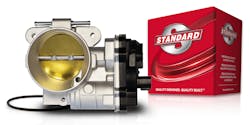A Closer Look: Electronic Throttle Bodies and Control Systems
Electronic Throttle Control Overview
The majority of vehicles on the road today use Electronic Throttle Control (ETC). These systems help improve fuel economy, reduce emissions, protect powertrain components, and provide an overall better driving experience. While ETC is beneficial, there are faults that occur. These can be frustrating for the motorist as well as technicians. Quite often an intermittent fault will happen for an instant but will result in a limp-in condition for the motorist. Customers may show up at the shop with an array of concerns caused by ETC systems – inoperative cruise control, vehicle stuck in limp mode, warning lamp illuminated.
The Accelerator Pedal Position sensor (APP)
The Accelerator Pedal Position sensor (APP) is the driver’s input to the PCM. Previously the driver would press on the accelerator pedal which would pull on a cable that was connected to the throttle blade. There was a Throttle Position Sensor (TPS) attached to the throttle blade that would report this request to the PCM along with feedback as to the actual position of the throttle blade.
On ETC vehicles, the driver still presses on the accelerator pedal, but in most applications, there is no longer a cable attached to the pedal. Instead, an APP is mounted to the pedal. The APP consists of two or more sensors that act as an input device to the PCM or the ETC standalone module. Multiple inputs are important for failsafe measures. As a critical input for safety, there is a system of checks and balances to prevent unintended acceleration or no acceleration. Frequently these sensors will work opposite of each other, or change at varying rates so the control module can assume that the signal lines aren’t shorted together.
The Powertrain Control Module (PCM)
The Powertrain Control Module is still the brains of the operation. Some ETC applications have a standalone control module, but most rely on the PCM to analyze inputs from the APP, then command the throttle body to respond accordingly. The PCM will then analyze the feedback from multiple Throttle Position Sensors to monitor the position of the throttle blade and adjust its position according to the driver’s request and the vehicle’s demand.
The throttle body is where the actual work is performed as it receives the command from the PCM. There isn’t a direct correlation between the APP and the throttle opening, and just because the driver has the pedal pressed to the floor, the throttle body won’t necessarily be wide open. The PCM commands throttle open based on a number of inputs and driving conditions. In the capture above, the driver pressed the APP all the way to 100%, but the throttle angle gradually changed to protect the powertrain.
Electronic Throttle Bodies
Most throttle bodies have two wires that control the throttle body motor function similar to the control of a power window motor. To drive the throttle blade open, power will be supplied on one wire while the other wire is supplied ground. In order to close the throttle blade, the polarities are reversed.
The throttle body also incorporates multiple Throttle Position Sensors. These are similar to the APP sensors as multiple sensors are used for safety and each sensor operates independent of the others.
When attempting to diagnose an Electronic Throttle Control fault, it is important the technician follow Diagnostic Trouble Codes carefully, always check Technical Service Bulletins and look for software updates. Many times, the DTC will be divided into three areas: APP, logic (PCM or wiring), or throttle body (TPS). Other areas of the vehicle’s control system may cause throttle related symptoms that aren’t necessarily faults of the electronic throttle control system. Faults such as wheel speed sensors could affect throttle opening and should be diagnosed first.
Tech Tip
To avoid idle drivability concerns, after a component from the electronic throttle system has been replaced, it’s important that the PCM memory be erased, and the electronic throttle control system values be learned. Some vehicles require a reflash, others an extensive relearn procedure, but some manufacturers’ procedures are relatively simple. These values can be learned by operating the engine for two minutes in park with AC off, two minutes in park with AC on, two minutes in drive with AC off, two minutes in drive with the AC on.
Premium Replacements for a Growing Category
The Electronic Throttle Control system offers many parts replacement opportunities. Electronic Throttle Bodies (ETBs) have high O.E. failure rates and when the original part fails, it can impact the vehicle's power, fuel economy, and drivability. When selecting a replacement Throttle Body, remember that quality matters, so make certain you choose the right replacement ETB.
Standard® offers the most comprehensive ETB line in the aftermarket – more than 200 premium ETBs covering 175 million VIO. Every Standard® ETB is 100 percent new, not remanufactured, and each undergoes extensive calibration and testing. All Standard-manufactured ETBs are built in North America in an IATF 16949-certified facility. As an expert manufacturer, Standard® designs upgrades to failure-prone OE components and includes ETB gaskets where required.
For more information on diagnosing and replacing these components, search “Throttle” on the StandardBrand YouTube channel or visit StandardETB.com.
